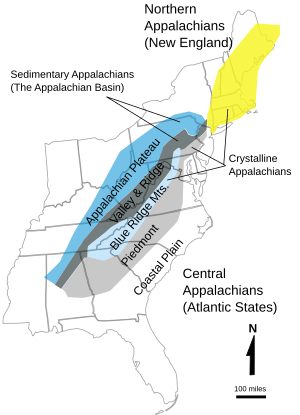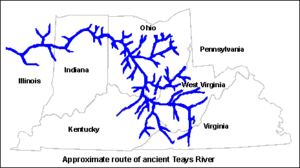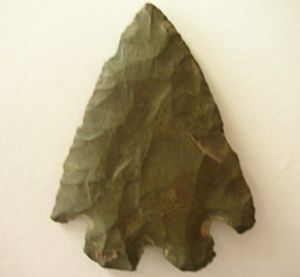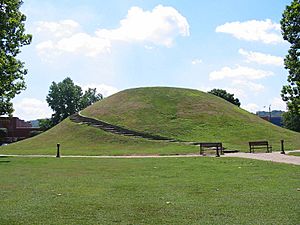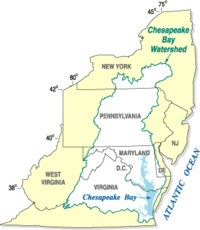Prehistory of West Virginia facts for kids
The Prehistory of West Virginia covers the time from when the first people arrived until Europeans came in the early 1600s. Hunters explored West Virginia's mountain valleys and set up temporary camps thousands of years ago.
Many ancient man-made earth mounds from different mound-building cultures still exist. You can find them especially in areas like Moundsville, South Charleston, and Romney. Objects found in these places show that people lived in villages and traded with other groups. They even used a little bit of cold-worked copper. As of 2009, over 12,500 ancient sites have been found in West Virginia!
Contents
First People in West Virginia
The earliest signs of humans in West Virginia date back to about 11,000 BCE. These were nomadic people called Paleo-Indians. They moved around a lot.
From 7000–1000 BCE, different Native American cultures grew in the Northern Panhandle, the Eastern Panhandle, and the Kanawha River Valley. They built temporary villages along the Kanawha, Monongahela, and Potomac rivers, especially in the Allegheny Mountains. Early people used tools like the atlatl, which was a spear-thrower.
Scientists who study cultures look at how ideas and items spread between ancient peoples. This helps them understand how groups traded, moved, and sometimes even married or absorbed each other's ways of life.
West Virginia's Ancient Landscape
West Virginia is part of the Allegheny Plateau, which was not covered by glaciers. This area includes parts of the Allegheny Front and the Ridge-and-Valley Appalachians. The land rises from the Ohio River Valley in the west up to the Allegheny Mountains in the east.
The lowest parts of the state are about 550 to 600 feet (168 to 183 m) above sea level. The lowest point is along the Ohio River at 538 feet (164 m). In the east, the Potomac River flows along a plateau that is about 2,000 feet (610 m) high. The Allegheny Mountains do not have volcanoes and have very few earthquakes.
These mountains were formed millions of years ago when the North American Plate moved. About 350 to 300 million years ago, during the Carboniferous period, the Taconic Orogeny created much taller mountains in eastern West Virginia. These ancient highlands provided the sediment that formed rocks during later periods. Fossils of ancient animals are found in the layers of rock, especially near coal seams and natural gas deposits.
During the Ice Age, about 2.6 million years ago, a large body of water called Glacial Teays Lake existed. It stretched from southern Virginia through the New Kanawha River to the ancient Teays River. This river flowed through Ohio, Indiana, and Illinois to the Mississippi River. West Virginia itself did not have large ice sheets during the last Ice Age, but smaller lakes formed among the mountain peaks.
The deeply carved river valleys, like Canaan Valley and Blackwater Canyon, are called Paleozoic Plateaus. Melted ice and weather slowly eroded the hills and mountains. Ancient sediments and gravel layers can be found under the soil in the valleys. Many different kinds of stones for making tools are found across the state. These stones show that Paleo-Indians traveled through West Virginia.
Ancient Forests and Journeys
The changing natural environments of West Virginia affected how ancient Native Americans moved around. The land slowly changed from a cold, treeless tundra to an evergreen forest, and then to forests filled with oak, hemlock, and nut trees. These forests attracted animals like deer, bears, and wild turkeys by 7800 BCE.
The New River flows from the Ridge-and-Valley Appalachians and connects to the Tennessee River. Other rivers like the Big Sandy River also drain this area. These rivers and ancient mountain trails helped Native Americans travel between the northern plains of Illinois, Indiana, and Ohio, and the Piedmont Plateau and Atlantic Ocean coast. These trails were used for moving, trading, hunting, and even for warfare.
Between 10,800 and 9500 BCE, huge glaciers in the north began to melt, causing big floods. These floods disturbed ancient campsites along rivers. The Hopewell culture arrived from Ohio and Indiana about 2,000 years ago. They traded with earlier groups like the Armstrong people and the Adena culture. Copper from Wisconsin has been found in some Adena mounds, showing a wide trade network.
Ancient Weather Patterns
Scientists study prehistoric weather to understand how the climate changed. A very cold period called the Younger Dryas Stadial happened from 10,800–9500 BCE. Temperatures dropped sharply, and sea levels fell. Nomadic Paleo-Indians arrived in the upper Ohio Valley during this time. By 9500 BCE, the cold period ended, and warmer temperatures returned.
A warm period called the Holocene climatic optimum occurred between 7000–3000 BCE. Towards the end of the Archaic period, large storms came from the Gulf of Mexico. The western and northern valleys of West Virginia became warm and dry around 2550 BCE. This caused plants to thin out and led to occasional floods and erosion.
Later, there were periods of drought followed by cooler, wetter times. The weather patterns in the Ohio Valley influenced farming. For example, from 1350–1600 CE, the upper Ohio Valley had milder weather, which was good for growing corn.
Paleo-Indian Period
Paleo-Indian culture appeared in West Virginia around 10,500 BCE, mostly along major river valleys. The New Trout Cave in Pendleton County is an ancient cave shelter studied by archaeologists. Large animals like American mastodons and woolly mammoths lived in the Kanawha Valley but either died out or moved north as the climate warmed.
The Meadowcroft Rockshelter in Pennsylvania, not far from West Virginia, has evidence of Paleo-Indian life dating back to 11,320–14,225 BCE. Stone from West Virginia was found there, showing that people traveled and traded over long distances.
The Clovis culture left behind special spear points called Clovis points in West Virginia. Later groups, like the Plano cultures (8000-7000 BCE), made different types of spear points.
Archaic Period
The Archaic period, from 8000–2000 BCE, was a time of warmer climates. Archaic people in West Virginia were hunter-gatherers. They fished and collected wild berries, nuts, seeds, and plants. Since the very large animals had disappeared, they hunted deer, bear, and wild turkeys using atlatls and small spears. Atlatls used special stone weights called bannerstones.
They also used tools made from ground stone and flint for woodworking. They made bowls from sandstone and soapstone, as well as knives and net sinkers for fishing. In the Kanawha Valley, many tools were made from a local stone called Kanawha Black Flint.
Around 2000 BCE, people started building large, cone-shaped mounds. These mounds often had log structures at their base. The Early Eastern Woodland people, known as the Adena moundbuilders, arrived from the east and built these mounds.
Archaeological Site Numbers
Today, when new buildings or highways are planned, archaeologists must survey the land first. They identify "dig sites" using a special numbering system. For West Virginia, the state ID number is "46". The next part is an abbreviation for the county. For example, the first site in Mingo County is 46MO1. This helps scientists keep track of all the important historical places.
Woodland Period
The Woodland period lasted from 1000 BCE to 1000 CE. This period is different from the Archaic period because people started farming, making pottery, and building burial mounds.
Adena Culture and Their Mounds

The Adena Culture, which started in Ohio, thrived in West Virginia from 1000–200 BCE. Adena people were farmers and lived in settled villages. Their villages were spread across the Midwestern United States and were connected by trade.
Adena houses were usually cone-shaped, about 15–45 feet (4.5–13.7 m) wide. They were built around supporting poles, with roofs made of bark and walls of wickerwork or bark.
Adena farmers grew crops like squash, sunflower, and other native plants. They also grew gourds for containers and rattles. They were not known for raising many animals, but they did grow Tobacco, which they smoked in special pipes.
Adena leaders sometimes wore animal heads during ceremonies. They made rough cloth and colored it with natural dyes. They also placed red ochre in important graves. They even changed the shape of their heads on purpose. They made cordage from animal sinew, hides, and plant fibers.
Later, around 500 BCE, a new group with more political power arrived from north of the Ohio River. Many Late Adena people moved south of the Ohio River, joining their relatives. Some even went as far as the Chesapeake Bay area. Their mounds became smaller over time.
Many Adena mounds were used as burial sites. Often, the dead were cremated and placed in log tombs, which were then covered with dirt to form a cone-shaped mound.
Famous Adena mounds in West Virginia include:
- Criel Mound, Kanawha County (250–150 BCE)
- Cresap Mound (46MR7), Marshall County (1735 BCE)
- Grave Creek Mound, Moundsville (250-150 BCE)
- Turkey Creek Mound (46PU2), Putnam County (886 CE)
The Grave Creek Mound in Moundsville is the largest mound in the state. It was once surrounded by a ditch.
Other Woodland Groups

Early Woodland people from the east began trading with the late Archaic people in West Virginia. They set up camps on floodplains, terraces, and hilltops. They also dug storage pits for food. The earliest pottery in the region is called Half-Moon Ware.
The Middle (1-500 CE) and Late Woodland (500-1000 CE) periods in West Virginia's Northern Panhandle included cultures like Adena and Late Hopewell. Burial ceremonies and mound building slowly became less common by the end of the Woodland period. However, growing tobacco might have led to more complex societies. Early Woodland people lived in more settled ways.
The Fairchance Mound and Village in Marshall County, West Virginia is a Middle Woodland site. It has a unique stone-lined burial area. The people there ate wild plants, animals, fish, and shellfish.
Corn farming appeared in the Late Middle Woodland period (550–950 CE) and became an important crop. "Climbing beans" were grown with corn by the 14th century. The use of the atlatl was slowly replaced by the bow and arrow during the Late Middle Woodland period. Both tools were used in West Virginia at this time.
Late Woodland people lived in larger wigwam settlements within their territories. They also used temporary rock shelters for hunting further away.
Hopewell Mounds
- Romney Indian Mound, Hampshire County (500–1000 CE)
- Oak Mounds, Harrison County (1–1000 CE)
Monongahelan and Fort Ancient Traditions
Late Prehistoric cultures (1200–1550 CE) likely had different languages. In these small farming villages, people used shell hoes, ceramic pipes, bone fishhooks, shell-tempered pottery, and triangular arrow points. Early and Middle Fort Ancient groups lived in their villages all year round.
Monongahelan People
The Monongahela people first lived in farm fields and small villages without walls, along the broad river valleys. The Worley village Complex in Monongalia County, West Virginia, dates to about 900 CE. Their pottery was often "bag shaped" or tear-drop shaped.
As they faced challenges, their circular villages became surrounded by palisades (log walls) and moved closer to ridge gaps. These villages were smaller than Fort Ancient ones. Late Monongahela people (1580–1635 CE) may have been middlemen in a trade network for marine shells, reaching from the Chesapeake Bay to Ontario.
Fort Ancient People
The Fort Ancient Tradition thrived from about 1000 CE through 1550 CE. Scientists now believe these farming villagers in the Central Ohio Valley developed their culture from within the region, rather than from the Mississippian culture. The Fort Ancient people in West Virginia are known as Eastern Fort Ancient.
The Blennerhassett Phase of the Fort Ancient Tradition appeared by 1250 CE. These people no longer used small burial mounds. Graves were found among the houses around a central open area. Their houses were usually rectangular with rounded corners or oval-shaped. They became skilled at building log palisades around their circular villages. During this time, they ate much more corn. They also continued to hunt small mammals, birds, fish, and deer.
The Feurt Phase (1028-1720 CE) lived along the Ohio Valley. They used local flint for their tools. The Bluestone Phase (1028–1463 CE) were Fort Ancient farmers in the highlands of southern West Virginia.
Protohistoric Period
The Clover Phase (1450–1640 CE) lived in the western part of the state, along the lower Great Kanawha and Ohio rivers. The Clover Site is a very important archaeological site from this period.
Bow and Arrow
The bow and arrow for hunting appeared in the region around 500 CE and was clearly used at village sites in West Virginia by 800–900 CE. The use of the arrow spread from the north and northwest valleys to the eastern mountain slopes. Early arrow points like the Jacks Reef and Levanna types are found in the state.
Hunters and warriors began to use the bow and arrow more, though the atlatl and dart continued to be used alongside arrows into later times. The main trade routes were along the Ohio River and its tributaries, connecting to the Tennessee River system, and the James River and Potomac River to the Chesapeake Bay.
Forts were built to defend against raids on these settled farming communities. At the Buffalo Site, archaeologists found bodies with arrow points in them, suggesting warfare. Later, larger towns without palisade walls appeared. People in these towns would leave after the growing season to go to winter camps upriver to hunt for furs to trade.
These ancient bowmen hunted animals like deer, bear, and wild turkeys. They also hunted elk and mountain lions, which are no longer found in West Virginia today.
Stone Tools and Art
Scientists can often tell where ancient stone tools came from by looking at the color and texture of the chert (a type of rock). Today, they use advanced techniques like Neutron Activation Analysis to identify the exact source of the stone.
It is legal to dig for arrowheads on your own private property in West Virginia. However, if you find any suspected human bones, you must stop digging and report it to the county sheriff. They will contact the right people to investigate.
Many large stones in West Virginia are decorated with Native American art called Petroglyphs. Most are on rock outcrops and boulders overlooking stream valleys, or carved into creek bed boulders. Sadly, many of these "picture rocks" were removed and used for building in the 1800s.
There are also reports of Native Americans building stone fishing weirs in creeks to help catch fish. Some ancient stone walls have also been found. For example, a long stone wall near Mount Carbon was described as being six or seven feet high and well-built in the 1800s. Some believe it was used to herd animals towards gaps where hunters waited.
Native American traditions suggest that springs near flint outcrops had spiritual meaning, seen as portals to other spiritual worlds. The "Flint Spirit" was believed to live in these outcrops. The spirits of travelers and the river itself also held religious importance.
Ancient Pottery
Early bowls made of steatite (soapstone) were slowly replaced by sandstone bowls, and then by ceramic (clay) bowls. The earliest pottery in the region is called Half-Moon Ware.
Different types of pottery appeared over time:
- Johnson Plain and Levissa Cordmarked were early Middle Woodland pottery from Ohio.
- Watson pottery appeared later in the Middle Woodland period (100–800 CE). It was often cord-marked or plain.
- Mahoning pottery (Middle-Late Woodland) was made using a coil method with crushed rock.
- Armstrong pottery (1–500 CE) was thin and often had a glazed yellow-orange color.
- Buck Garden pottery (500–1200 CE) was made with crushed rock and cord-marked.
- Page pottery (900–1450 CE) was limestone-tempered and cord-marked.
- Drew pottery (900~1350 CE) had a high percentage of plain ware and some unique neck decorations.
- Monongahela pottery was tempered with crushed shell and often had cord-markings.
- Feurt-incised pottery (starting around 1100 CE) used shell tempering and had incised lines.
Scientists study the direction of the cord twist on pottery (S-twist or Z-twist) to understand how different groups were connected. For example, Z-twist cordage was more common in southern West Virginia during the Late Prehistoric period.
Recently, archaeologists found pottery with corncob impressions at the Burning Spring Branch site. This suggests that groups from southwestern Virginia might have moved through West Virginia.
There is no clear evidence of Classic Mississippian culture pottery found in West Virginia. The closest pure Mississippian sites are further west in Indiana.
Mid-Atlantic Pottery Types
Here are some pottery types found in the Mid-Atlantic States:
- Accokeek pottery (900–300 BCE) found in Maryland and Virginia.
- Clemson Island pottery (800–1400 CE) found in Maryland, Pennsylvania, and West Virginia's Eastern Panhandle.
- Keyser pottery (1400–1550 CE) was shell-tempered and cord-marked, found across the region.
- Marcey Creek pottery (1000–750 BCE) found from Delaware to Virginia.
- Schultz pottery (dating to 1600 CE) had incised patterns, found in western Maryland, Pennsylvania, and West Virginia.
- Selden Island pottery (1000–750 BCE) found from Virginia to Pennsylvania.
- Shepard pottery (900–1450 CE) found in Maryland.
- Townsend ceramics (950–1600 CE) were shell-tempered and fabric-impressed, found on the coasts of Maryland and Virginia.
- Vinette pottery (600 BCE–200 CE) found on the east coast from New England to Maryland.
Some Important Archaeological Sites
- Childers, 46MS121
- Watson, 46HK34
- Fairchance, 46MR13
- Jenkins House Site, 46CB41
- Niebert, 46MS103
- Woods, 46MS14
- Parkline Site, 46PU99
- Buck Garden, 46NI49
- Winfield Locks Site, 46PU4
Images for kids


